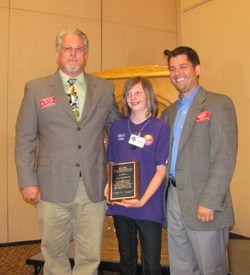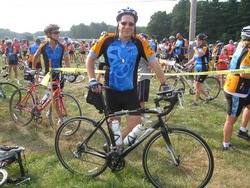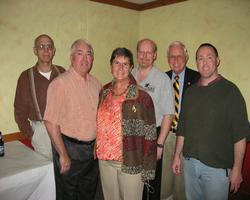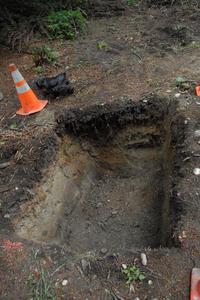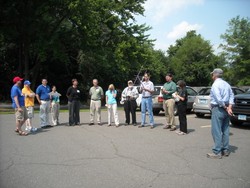 August 17, 2011 Editor: Ward Silver, NØAX | |||||||
IN THIS ISSUE
NEW HF OPERATORS - THINGS TO DO I hope new operators will take a spin in the ARRL's RTTY edition of the Rookie Roundup - it's geared to a pace that operators new to HF will find comfortable. Don AA5AU's website on RTTY Contesting has loads of "how to" and "getting started" tips and guidelines. I hope to hear you on Sunday! BULLETINS There are no bulletins in this issue. BUSTED QSOS Your editor's spelling having improved "considerable", the Busted QSO section will remain quiet for this issue. CONTEST SUMMARY Complete information for all contests follows the Conversation section Aug 20-21
Aug 27-28
The North East Weak Signal Group (NEWS) is proud to sponsor the combined Eastern VHF/UHF Conference and Microwave Update 2011 Conference in Connecticut October 13-16. The conference committee consists of volunteers from NEWS, the Mt. Airy VHF Radio Club (PackRats) and others. The program begins on Thursday with a tour of the Haystack Observatory in Massachusetts and numerous speakers already lined up to give presentations on Friday and Saturday. There will be vendor's displays, Lab Measurement sessions, both indoor and outdoor selling, and much more. (Thanks, Ron WZ1V)
If you are interested in the ongoing competition for WRTC 2014 positions, you should visit the WRTC Rank website! The qualification standings are based on claimed and final contest scores to help operators seriously interested in qualifying to WRTC2014 to track their scores and other competitors. The website has recently made some changes and improvements - take a look! Site manager Marek SQ2GXO reminds us that WRTC Rank is not an official site - official scores are maintained by WRTC 2014 committee member Dan K1TO. Don't forget about the inaugural CW OPEN contest coming on Aug 20 and 21 to a band near you! Logging modules are supported on: N1MM, WriteLog, TR4W, and other contest logging software (see www.cwops.org/cwopen.html). The unusual format of multiple operating periods should be fun to try! (Thanks, Alan AD6E and Rob K6RB) Tree N6TR has been off in the land of Zone 19 recently as judge of the Friendship Radiosport Games. He is the judge for the CW events and will be participating in the direction-finding event with his daughter, Theresa. Dave W9ZRX would like to put out an update to the VHF Super Partial Check files before the ARRL September VHF Contest. He would appreciate it if you would send him a copy of your Cabrillo-formatted log from the July CQ VHF Contest.
DXCC Manager, Bill NC1L notes that dxcc@arrl.org is no longer in use. A number of new e-mail addresses will be used to insure that your email will be delivered to the most appropriate person depending upon the subject. The Scandinavian Activity Contest pre-issue of Pileup! will be published in early September. The editors are looking for any contest-related materials, serious or humorous, perhaps even both. Your experiences and tips in working SAC from outside Scandinavia would be especially welcome. (Thanks, Ilkka OH1WZ) Hector XE2K reports on a new project or experiment from the Grupo DXXE led by Joaquin XE1R. The new gazette will share experiences and writeups from the members. The gazette will be in Español to begin with and they have just published edition numero uno. A second issue may be available as this newsletter is published. The editors will appreciate your comments and recommendations. The Northern Lights Radio Society (NLRS) sponsors the Limited Rover Award with rules based on participation in the ARRL's UHF contest. If you submitted a log for that contest, you might quality! Check out the rules and rewards on the NLRS website. (Thanks, Todd KC9BQA) Todd also reports on another VHF+ participation-stimulating program - the Wisconsin V/UHF County Hunters Award or WIVUCH. If you work at least 20 WI counties on any mix of bands 50 MHz and above - no repeater contacts allowed - you will receive an initial certificate. I can think of several regional VHF+ clubs that could sponsor a local equivalent! The Aleutians are easy to find on a map but not so easy to get to! Nevertheless, Yuri N3QQ, John KE7V, and Yuri UA9OBA were able to hitch a ride from VP8DEU and put St Matthew on the air as KL7RRC as described in this ARRL website story. (Thanks, Yuri N3QQ)
Very sad news comes from the U. S. heartland about the death of Tom Hammond NØSS after a very long battle with cancer. Contesters who attended the Dayton Hamvention will remember Tom, especially his increasingly sophisticated and challenging CW Pileup competitions sponsored by the Kansas City DX Club. Tom was a personal friend for many years and Elmered many, many hams and contesters in the mid-Missouri area, including multiple world-record-holder Jeff N5TJ, then NØAQK. Tom was also a linchpin of the state's emergency communications team and made countless other contributions to Amateur Radio, including the Elecraft community. Web Site of the Week - AMSAT is happy to announce the ARISSat-1 Chicken Little Contest. This is your opportunity to calculate, or guess, when ARISSat-1 falls out of orbit, defined as the time it crosses an altitude of 78 kilometers, which is considered to be the point of no return. While not part of the contest, the actual reentry may be visible depending on location. There are two student divisions and one adult division for the contest. Group submissions are encouraged with a limit of one per group or individual. (ANS thanks ARISSat-1/KEDR team for the above information and we thank AMSAT for the information from AMSAT bulletin ANS-226) The recent Contest University held in Brazil generated a lot of Latin America buzz! Diego LU8ADX snapped a whole lot of photographs during the festivities and you'll recognize many familiar call signs from your contest logs. John WØUN reminded me of this interesting video of coupled pendulums. It makes a restful lesson in physics, doesn't it? WORD TO THE WISE Equinox - the vernal (spring) and autumnal (fall) equinoxes are the days on which there are equal amounts of light and dark. Hams also know them as the days on which the grey line goes directly over the poles, making for some very long-haul DX QSOs! Contest season is ramping up and is considered to be in full swing after the autumnal edition. There are loads of contest results to announce in this issue - we must have been very busy this past six months! Results for the 2011 ARRL DX SSB Contest are now online. Certificates for the 2010 ARRL 10 GHz & Up Cumulative Contest have also been mailed - you can track the status of ARRL contest award processing online, as well. Make sure your club or group's Field Day submission is in the files by having a look at the Field Day Submissions page. (Thanks, ARRL Contest Branch Manager, Sean KX9X)
Sean KX9X also congratulates Thomas Johnson WD5K of Dallas, TX for earning The ARRL Fred Fish Memorial Award (FFMA) #5. Tom submitted confirmation of his last-needed grid, CN77 and Tom's application was reviewed and approved by ARRL on July 28, 2011. Sam VE5SF reports that results for the 2010 Canada Winter Contest are now available on the RAC website. We also have a basket full of state QSO party results: Alabama QSO Party (Thanks, Jim KC4HW) Georgia QSO Party (Thanks, John K4BAI) Michigan QSO Party (Thanks, Dave K8CC) Wisconsin QSO Party (Thanks, Lynn K9KR) Gmail users might want to check their system's Spam folder as there have been a number of reports about email containing notices of CQ WW Log Checking Reports (LCR) winding up there and not in the Inbox. This is apparently the result of some aggressive spam filtering and may not be a long-term issue but if you participated in the CQ WW and haven't received email for your LCR, take a look. Putting noreply@cqww.com in your Contacts list will also notify the spam filter to pass messages from that address. (Thanks, Bob N6TV) OPERATING TIP Be prepared when you get on for a busy contest weekend - if there are several contests active, print up some paper log sheets to record contact information from contests other than the one on which you're focusing. That way you can hand out points to everybody and probably add QSOs to your contest log, as well. After the contest, enter the QSOs into your computer log and generate a Cabrillo file by using the LogConv program from KA5WSS or other Cabrillo-friendly software. You may get an unexpected certificate for your troubles! Tom K8AZ has some good advice for stack builders. Measure or frequency sweep the feed lines to be odd ¼-wave multiples. Make sure you include in the length any jumper from the tower to the antenna balun and the balun, too. When building feed lines, use coax off of the same spool.... and sweep it with an MFJ 259 or equivalent. Use identical baluns and make sure you know the phasing. Once installed, mark one side of the driven element (DE) with red tape so you'll be able to tell what the proper phasing is years later when you're likely to have forgotten. (Of course, you do keep a station notebook, don't you?) The point about including baluns in the ¼-wavelength is well taken - the phase shift through a balun is generally not specified and can be significant. If you want a specific electrical length of feed line between your transmitter and the antennas, be sure to include the entire feed line including baluns, PL-258 adaptors, jumpers, and so forth. Speaking of baluns, if your choke balun is getting warm, why? High choke balun dissipation occurs when it doesn't have sufficiently high common mode impedance at the frequency of use. For the reasons why, read Kevin Schmidt W9CF's paper on the effects of balun location in your antenna system and the necessary impedance to get the job done! Peter PC2A points us to a good discussion of how to use one Beverage antenna at different frequencies by using band-pass filters as a splitter. The VP6DX group used this technique and it worked very well! More on Beverage antennas is waiting for you on Mike WØBTU's web site. Just about every question you have on Beverages is addressed.
You've probably heard that placing dissimilar metals in contact with each other promotes corrosion but which combinations are better or worse than others? The farther apart the metals are in the Galvanic Series, the stronger the corrosion effects. The Corrosion Source website is full of good information about corrosion and how to prevent it. Russ KB8U has placed pictures and text describing his portable Moxon rectangle for 6 meters on his website. It assembles in about a minute, not counting hooking up the coax. There's plenty of life left in the summer sporadic E season and the ARRL September VHF QSO Party is not far away! Another multi-antenna resource page is published by Martin SMØDTK. There are lots of antenna designs including the "Mini Horse" beam with dimensions for 40 through 2 meters. Technical Web Site of the Week - There are lots of cookbook solutions to guy cable selection but if you really want to know the details, check out K7NV's excellent engineering analysis. Each common type of guy cable is described and characteristics compared. Good stuff! (Thanks, Pete N4ZR) A Personal Touch Not so long ago, I was outside just after a warm summer's dusk with a group of friends, enjoying the good weather and clear skies. I also knew that the International Space Station was going to make a long, high-elevation pass at about the same time and suggested that the group move into the clear where they could see it. Several were amazed to find out they could see it from the ground without a telescope and I assured them it would be surprisingly bright. (You can find visible passes of the ISS, optical flares from the Iridium satellite solar panels, amateur birds, and many other space objects at the Heavens-Above website.) As we scanned the southwestern skies, I fielded questions about how high the station was (about 200 miles) and how fast it would travel (this pass was going to last more than four minutes) and how I knew this (the web is pretty useful at times). Then, right on time, a bright spot of light suddenly became visible and the questions turned to appreciative comments as it climbed up toward the zenith and passed overhead. As an added bonus, just before the pass was over, the station passed into the Earth's shadow and abruptly winked out, so I got to explain that, too. I fielded a lot more questions and I'm sure several of the watchers have done the same on their own since that evening. What does this have to do with ham radio? Well, quite a bit, actually. While my friends knew of the station, they had never actually seen it. It was an abstract bit of knowledge that had little connection to their daily lives. But standing outside on a summer evening, watching it travel overhead and knowing that there were astronauts on board changed everything. That personal, visceral experience gave them a connection to what was just some initials an hour before.
Less long ago (like last weekend) I attended the annual Pacific Northwest DX Convention this weekend - I had a great time seeing all my friends again and catching up on how things were going in this far-flung corner of the U.S. It's said you can't go home again and that may be true...but you can sure visit! As I pulled into the Everett Holiday Inn parking lot, I noticed a large semi-trailer out front on the street painted a raucous lime green and festooned with insignia and logos. As it turned out, the Endurocross motorcycle race was being held on the same weekend and we were sharing the hotel with a lot of racers and fans. As you might expect, there was some overlap between the two groups, such as at breakfast. They were curious about the badges and call signs and after we got past the inevitable, "Ham radio - do you still do that?" they were quite interested in our "radio cross" events and DXing and that sort of thing. The key point, though, is that they were completely unaware of our existence. The big semi had on its side a logo for the "world's fastest radio control technology" - so it's not like the race crowd is unaware of wireless technology. They are just unaware of us - that people are still using radio for fun and not as a kind of "smart wire" was news to them. We've essentially dropped out of that conversation because we had no connection with their lives. Without that personal connection, ham radio has little chance of re-entering their conversation with the world. Here's where you and maybe your club come in. Unless we - as in you and I - get out there and put ourselves in the public eye, we (and ham radio) are going to stay a caricatured mystery to the lay public even though they may be technically savvy and bright. People are not going to pick up a brochure and somehow get interested enough to participate in ham radio. They need to see real people doing something that looks useful (such as building a kit or antenna) and fun (such as radiosport). The "real people" I mentioned - that's you and me, folks. We have to get out of our basements and garages and spare bedrooms and put feet on the ground where people are. We need to be doing something where and when other people are around. A club can set up shop every so often at a mall or near sports fields (kids everywhere!) or in a favorite public park - anywhere people are likely to see you and have enough free time to ask questions. Just get out there and be yourselves! Laugh a lot. Smile and shake hands. Don't sit behind a table like it was a castle wall - stand out front and greet people in a friendly way. Talk to them and hand them a flyer with your website and lists of local clubs and stores - don't wait for them to take it. Look like you're having a good time, for crying out loud! It's amazing how well just having fun works as a marketing tool. A simple station will do - have somebody building a kit or accessory or antenna. You don't have to work DX, just make a few contacts a couple of states away. Have some test equipment - hint, kids love to talk into a microphone and see an oscilloscope trace jiggle. Print up some flyers about ham radio in your town - invite them to a club meeting. Have a demonstration of some special technique like working through a satellite or using a digital mode with a computer. If you can operate during a contest when contacts are made far and wide - set up a map on a piece of foam-core board and stick pins in to show where you've contacted. Just as a bright point of light in a darkening azure sky can open a mind in unexpected ways, so can a chance encounter with you and your radio, having a good time. You, too, can be an astronaut right here on Earth. 17 Aug to 30 Aug 2011 An expanded, downloadable version of QST's Contest Corral in PDF format is available. Check the sponsor's Web site for information on operating time restrictions and other instructions. HF CONTESTS ARRL Rookie Roundup--Digital, from Aug 21, 1800Z to Aug 21, 2359Z. Bands (MHz): 3.5-28, 50. Exchange: Both calls, name, check, S/P/XE or "DX". Logs due: See Web. Rules SARTG WW RTTY Contest--Digital, from Aug 20, 0000Z - see website. Bands (MHz): 3.5-28. Exchange: RST and serial. Logs due: Oct 10. Rules Russian District Award Contest--Phone,CW, from Aug 20, 0800Z to Aug 21, 0800Z. Bands (MHz): 1.8-28. Exchange: RS(T), serial or Russian district. Logs due: 30 days. Rules CWops CW Open--CW, from Aug 20, 1200Z to see website. Bands (MHz): 1.8-28. Exchange: Serial and name. Logs due: 5 Sep. Rules Keymen's Club of Japan Contest--CW, from Aug 20, 1200Z to Aug 21, 1200Z. Bands (MHz): 1.8-28, 50. Exchange: RST and JA pref/dist or continent. Logs due: Sep 21. Rules North American QSO Party--Phone, from Aug 20, 1800Z to Aug 21, 0600Z. Bands (MHz): 1.8-28. Exchange: Name and state. Logs due: 14 days. Rules Feld-Hell New Member Sprint--Digital, from Aug 20, 2000Z to Aug 20, 2200Z. Bands (MHz): 1.8-28. Frequencies: Monthly on 3rd Saturday. Exchange: RST, S/P/C, Feld-Hell member nr. Logs due: 7 days. Rules SARL Digital Contest--Digital, from Aug 21, 1300Z to Aug 21, 16009Z. Bands (MHz): 3.5-14. Exchange: RST and serial. Logs due: 7 days. Rules Run For the Bacon--CW, from Aug 22, 0100Z to Aug 22, 0300Z. Bands (MHz): 1.8-28. Frequencies: Monthly on 3rd Sunday night (local). Exchange: RST, S/P/C, Flying Pig nr or power. Rules ALARA Contest--Phone,CW, from Aug 27, 0400Z to Aug 27, 1359Z and Aug 28, 0400Z to Aug 28, 1359Z. Bands (MHz): 3.5-28, 144,440. Exchange: RS(T), serial, ALARA nr, name. Logs due: Sep 30. Rules Hawaii QSO Party--Phone,CW,Digital, from Aug 27, 0400Z to Aug 28, 2200Z. Bands (MHz): 1.8-28. Exchange: RS(T) and HI county/island or S/P/C. Logs due: Oct 1. Rules SCC RTTY Championship--Digital, from Aug 27, 1200Z to Aug 28, 1159Z. Bands (MHz): 3.5-28. Exchange: RST, 4-char year first licensed. Logs due: Sep 15. Rules YO DX Contest--Phone,CW, from Aug 27, 1200Z to Aug 28, 1159Z. Bands (MHz): 3.5-28. Exchange: RS(T), serial or YO district. Logs due: 30 days. Rules Kansas QSO Party--Phone,CW,Digital, from Aug 27, 1400Z to Aug 28, 0200Z and Aug 28, 1400Z to Aug 28, 2000Z. Bands (MHz): 3.5-28, 50,144, Frequencies: CW--40 kHz above band edge; Phone--3.840, 7.240, 14.240, 21.340, 28.440. Exchange: RS(T) and KS county or S/P/"DX". Logs due: Sep 30. Rules Ohio QSO Party--Phone,CW, from Aug 27, 1600Z to Aug 28, 0400Z. Bands (MHz): 3.5-28. Exchange: Serial and S/P or "DX". Logs due: 30 days. Rules South Africa DX Contest--CW, from Aug 28, 1400Z to Aug 28, 1600Z. Bands (MHz): 3.5-14. Exchange: RST and serial. Logs due: 4 Sep. Rules VHF+ CONTESTS ARRL 10 GHz and Up Contest--Phone,CW,Digital, from Aug 20, 6 AM to Aug 21, 12 AM. Bands (MHz): 10G+. Exchange: 6-character grid locator. Logs due: Oct 19. Rules ARRL Rookie Roundup--Digital, from Aug 21, 1800Z to Aug 21, 2359Z. Bands (MHz): 3.5-28, 50. Exchange: Both calls, name, check, S/P/XE or "DX". Logs due: See Web. Rules Keymen's Club of Japan Contest--CW, from Aug 20, 1200Z to Aug 21, 1200Z. Bands (MHz): 1.8-28, 50. Exchange: RST and JA pref/dist or continent. Logs due: Sep 21. Rules ALARA Contest--Phone,CW, from Aug 27, 0400Z to Aug 27, 1359Z and Aug 28, 0400Z to Aug 28, 1359Z. Bands (MHz): 3.5-28, 144,440. Exchange: RS(T), serial, ALARA nr, name. Logs due: Sep 30. Rules Kansas QSO Party--Phone,CW,Digital, from Aug 27, 1400Z to Aug 28, 0200Z and Aug 28, 1400Z to Aug 28, 2000Z. Bands (MHz): 3.5-28, 50,144, Frequencies: CW--40 kHz above band edge; Phone--3.840, 7.240, 14.240, 21.340, 28.440. Exchange: RS(T) and KS county or S/P/"DX". Logs due: Sep 30. Rules LOG DUE DATES 17 Aug to 30 Aug 2011 August 17, 2011 RSGB 80m Club Sprint, CW August 20, 2011 North American QSO Party, CW August 21, 2011 DMC RTTY Contest August 21, 2011 RSGB IOTA Contest August 22, 2011 10-10 Int. Summer Contest, SSB August 23, 2011 RSGB RoPoCo CW ARRL Information Click here to advertise in this newsletter. Your One-Stop Resource for Amateur Radio News and Information ARRL membership includes QST, Amateur Radio's most popular and informative journal, delivered to your mailbox each month. Subscribe to NCJ - the National Contest Journal. Published bimonthly, features articles by top contesters, letters, hints, statistics, scores, NA Sprint and QSO Parties. Subscribe to QEX - A Forum for Communications Experimenters. Published bimonthly, features technical articles, construction projects, columns and other items of interest to radio amateurs and communications professionals. Free of charge to ARRL members: Subscribe to The ARRL Letter (weekly digest of news and information), the ARES E-Letter (monthly public service and emergency communications news), Division and Section news -- and much more! ARRL offers a wide array of products to enhance your enjoyment of Amateur Radio. Visit the site often for new publications, specials and sales. Donate to the fund of your choice -- support programs not funded by member dues! ACKNOWLEDGEMENTS ARRL Contest Update wishes to acknowledge information from WA7BNM's Contest Calendar and SM3CER's Contest Calendar. | |||||||
